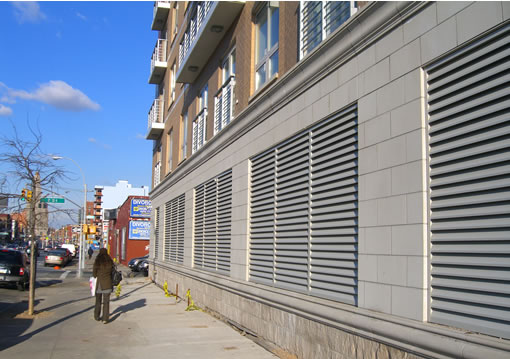City Planning Can Set the Bar Higher on Fourth Avenue
Well over a hundred people filled the auditorium of the Saint Thomas Aquinas Church last week for a forum on the future of Brooklyn’s Fourth Avenue put on by the Park Slope Civic Council. The stretch of Fourth Avenue on the western edge of Park Slope saw a wave of residential construction after a 2003 rezoning, but walking there still feels akin to navigating the shoulder of a highway. The new buildings and promises of a grand boulevard have raised expectations for the street, however, and the Brooklyn Paper reports that the forum conveyed a clear public desire for traffic calming and additional pedestrian space.
 On Fourth Avenue, "The Crest" meets the sidewalk with vents that mask ground-floor parking.
On Fourth Avenue, "The Crest" meets the sidewalk with vents that mask ground-floor parking.I was able to attend the second half of the forum, and better urban design also came across as a top priority. The new development on Fourth Avenue meets the sidewalk with blank walls, enormous vents, and curb cuts for ground-floor garages. The tenor of the audience’s questions made it clear that people are not happy about the quality of this walking environment. One exchange, in particular, I’ve been meaning to highlight.
When asked why the Department of City Planning failed to mandate transparency and active uses in the Fourth Avenue rezoning, Purnima Kapur, who heads the agency’s Brooklyn office, said that developers are too hesitant to commit to mixed-use properties in a newly residential area. "We would like to see retail on the ground floors, but in real estate, developers always lag behind demand," she said. Mandating retail, she later added, would cause some developers to not build at all, or ground floors to remain vacant.
But are developers really so risk averse? J. David Sweeny, an experienced Brooklyn developer and president of the PDS Development Corporation, allowed that "it’s hard to compel retail," but that such requirements could probably work on a street like Fourth Avenue, where 12-story buildings are now permitted, because "money is made above the ground floor."
"It’s not an excessive burden necessarily," he added. "The question is can you provide incentives so that they’ll rent the ground floor at a low enough rate" to attract retail tenants.
For the foreseeable future, however — or at least until the real estate cycle swings back around — Fourth Avenue is stuck with the planning decision to accept development with ground floors designed for cars and parking rather than pedestrians.
As for the overall prospect of transforming Fourth Avenue into a great boulevard and public space, that’s still "a twinkle in daddy’s eye," said Nick Peterson, a member of the Park Slope Civic Council who helped put together the forum. Organizers were very encouraged by the turnout, which included freshman City Council Member Brad Lander, and hopeful that the event will create more momentum. Going forward, it will be interesting to see if a sustained advocacy campaign starts to take shape around Fourth Avenue, similar to the broad coalition that has gradually won improvements at Grand Army Plaza.





